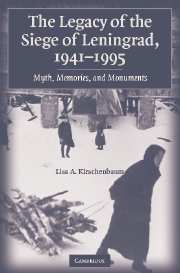Book contents
- Frontmatter
- Contents
- List of Illustrations
- Preface
- The Legacy of the Siege of Leningrad, 1941–1995
- Introduction
- PART I MAKING MEMORY IN WARTIME
- PART II RECONSTRUCTING AND REMEMBERING THE CITY
- 4 The City Healed: Historical Reconstruction and Victory Parks
- 5 The Return of Stories from the City Front
- 6 Heroes and Victims: Local Monuments of the Soviet War Cult
- PART III THE PERSISTENCE OF MEMORY
- Epilogue: No One Is Forgotten?
- Index
6 - Heroes and Victims: Local Monuments of the Soviet War Cult
from PART II - RECONSTRUCTING AND REMEMBERING THE CITY
Published online by Cambridge University Press: 27 July 2009
- Frontmatter
- Contents
- List of Illustrations
- Preface
- The Legacy of the Siege of Leningrad, 1941–1995
- Introduction
- PART I MAKING MEMORY IN WARTIME
- PART II RECONSTRUCTING AND REMEMBERING THE CITY
- 4 The City Healed: Historical Reconstruction and Victory Parks
- 5 The Return of Stories from the City Front
- 6 Heroes and Victims: Local Monuments of the Soviet War Cult
- PART III THE PERSISTENCE OF MEMORY
- Epilogue: No One Is Forgotten?
- Index
Summary
The exhibits inside the Heroic Defenders of Leningrad Memorial are documentary and symbolic at the same time.… The subdued nature of the exposition underscores the memorial's multiple intent as a place haunted with memories for those who lived through the siege, a museum of the city's history, and a venue for gala events.
Museum guide, 2001During and immediately after the war, a relatively small number of monuments marking the graves of fallen soldiers or commemorating victory appeared in the Soviet Union. After 1947, when Victory Day became an ordinary work day, the state substantially curtailed the ritual spaces and times allotted for reflecting on both the heroes and the victims of the war. The cult of the war that emerged after Josef Stalin's death changed all this. Local governments, with approval and funding from the state, undertook the construction of hundreds of war cemeteries and monuments. In 1965, Victory Day once again became a public holiday. By the early 1970s, monuments to the Great Fatherland War became ubiquitous features of the Soviet landscape.
Soviet monuments to the war ranged from understated markers to monumental statues situated in enormous memorial “complexes.” In general, they embraced traditional and idealized images of war. Unabashedly representational and resolutely optimistic regarding the justice of the cause, the heroism of the fighters, and the purity of the victory, Soviet memorials attempted to balance and integrate two essential tasks – mourning the country's staggering losses and celebrating the victory that, according to the myth of the people's war, crowned and redeemed the sorrows.
- Type
- Chapter
- Information
- The Legacy of the Siege of Leningrad, 1941–1995Myth, Memories, and Monuments, pp. 186 - 228Publisher: Cambridge University PressPrint publication year: 2006

